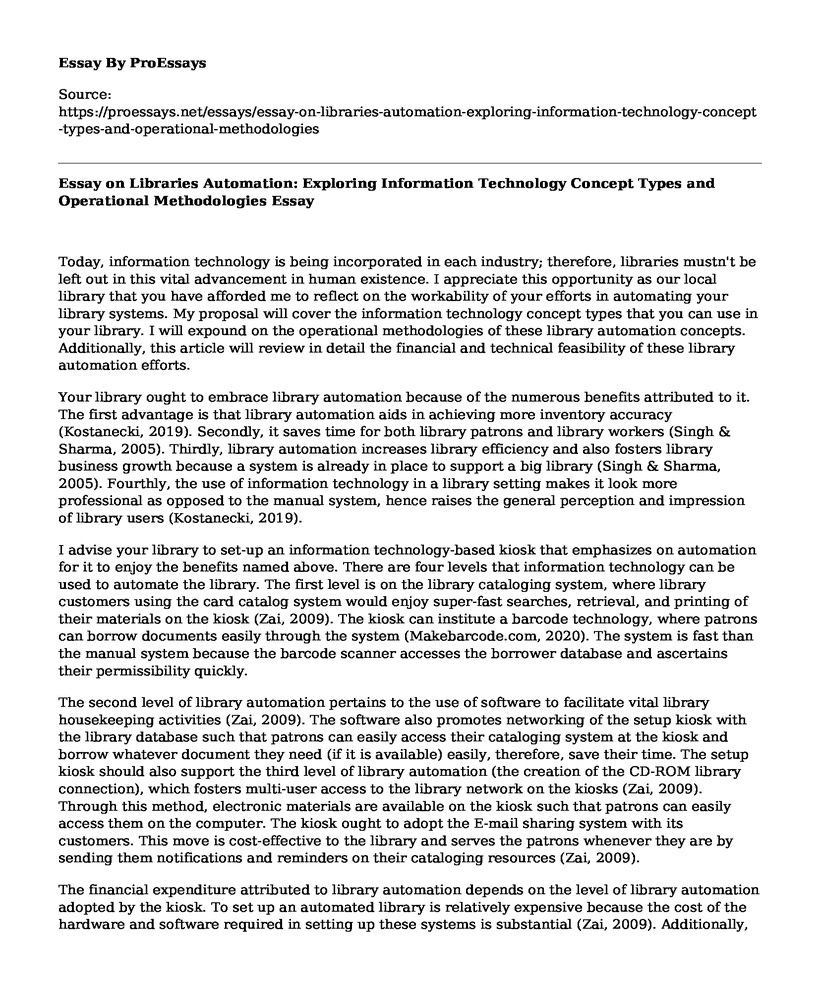Today, information technology is being incorporated in each industry; therefore, libraries mustn't be left out in this vital advancement in human existence. I appreciate this opportunity as our local library that you have afforded me to reflect on the workability of your efforts in automating your library systems. My proposal will cover the information technology concept types that you can use in your library. I will expound on the operational methodologies of these library automation concepts. Additionally, this article will review in detail the financial and technical feasibility of these library automation efforts.
Your library ought to embrace library automation because of the numerous benefits attributed to it. The first advantage is that library automation aids in achieving more inventory accuracy (Kostanecki, 2019). Secondly, it saves time for both library patrons and library workers (Singh & Sharma, 2005). Thirdly, library automation increases library efficiency and also fosters library business growth because a system is already in place to support a big library (Singh & Sharma, 2005). Fourthly, the use of information technology in a library setting makes it look more professional as opposed to the manual system, hence raises the general perception and impression of library users (Kostanecki, 2019).
I advise your library to set-up an information technology-based kiosk that emphasizes on automation for it to enjoy the benefits named above. There are four levels that information technology can be used to automate the library. The first level is on the library cataloging system, where library customers using the card catalog system would enjoy super-fast searches, retrieval, and printing of their materials on the kiosk (Zai, 2009). The kiosk can institute a barcode technology, where patrons can borrow documents easily through the system (Makebarcode.com, 2020). The system is fast than the manual system because the barcode scanner accesses the borrower database and ascertains their permissibility quickly.
The second level of library automation pertains to the use of software to facilitate vital library housekeeping activities (Zai, 2009). The software also promotes networking of the setup kiosk with the library database such that patrons can easily access their cataloging system at the kiosk and borrow whatever document they need (if it is available) easily, therefore, save their time. The setup kiosk should also support the third level of library automation (the creation of the CD-ROM library connection), which fosters multi-user access to the library network on the kiosks (Zai, 2009). Through this method, electronic materials are available on the kiosk such that patrons can easily access them on the computer. The kiosk ought to adopt the E-mail sharing system with its customers. This move is cost-effective to the library and serves the patrons whenever they are by sending them notifications and reminders on their cataloging resources (Zai, 2009).
The financial expenditure attributed to library automation depends on the level of library automation adopted by the kiosk. To set up an automated library is relatively expensive because the cost of the hardware and software required in setting up these systems is substantial (Zai, 2009). Additionally, the financial cost of an automated library system is increased because it requires highly recognized information technology professionals to create and manage the system (Singh & Sharma, 2005). Besides the cost of automated library is increased by the need to train library staff on how to use the system (Singh & Sharma, 2005).
Although there are financial constraints associated with library automation, the benefits of the development surpass the drawbacks; therefore, I highly recommend your library to set-up an information technology-based kiosk that embraces library automation.
References
Kostanecki, M. (2019, October 22). Barcoding Your Stock Is Easy - Learn How. Retrieved January 31, 2020, from https://www.inflowinventory.com/blog/barcoding-101/
Makebarcode.com. (2020). Information about Barcodes. Retrieved January 31, 2020, from http://www.makebarcode.com/info/info.html
Nancy. (2011, December 15). How Librarians Use ISBNs and Barcodes. Retrieved January 31, 2020, from http://authormaps.com/how-librarians-use-isbns-and-barcodes/
Singh, G., & Sharma, M. (2005). Barcode technology and its application in libraries and information centers. International Journal of Next Generation Library and Technologies, 1(1), 1-8. Retrieved from http://www.ijnglt.com/files/Barcode%20technology%20and%20its%20application%20in%20libraries%20and%20Information%20centers.pdf
Zai. (2009, March 20). Library Automation: Concepts, Theory and Practical. Retrieved January 31, 2020, from http://talsim.blogspot.com/2009/03/basics-of-library-automation.html
Cite this page
Essay on Libraries Automation: Exploring Information Technology Concept Types and Operational Methodologies. (2023, Mar 28). Retrieved from https://proessays.net/essays/essay-on-libraries-automation-exploring-information-technology-concept-types-and-operational-methodologies
If you are the original author of this essay and no longer wish to have it published on the ProEssays website, please click below to request its removal:
- Case Study: Internet Placed Coupons
- Evaluation Essay on Windows 7 Firewall
- Virtual Identity Essay Example
- Annotated Bibliography: Internet Addiction on Colleges
- Networking Tools: Technology Paper Example
- Harnessing Renewable Energy With Biomass: An Overview
- Cybersecurity: Defending Against 21st Century Threats - Annotated Bibliography







